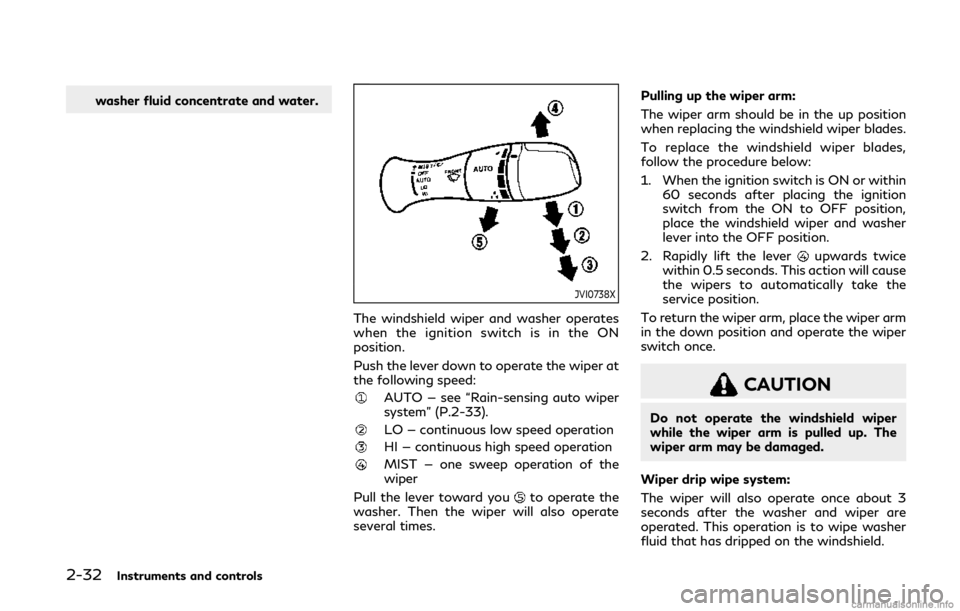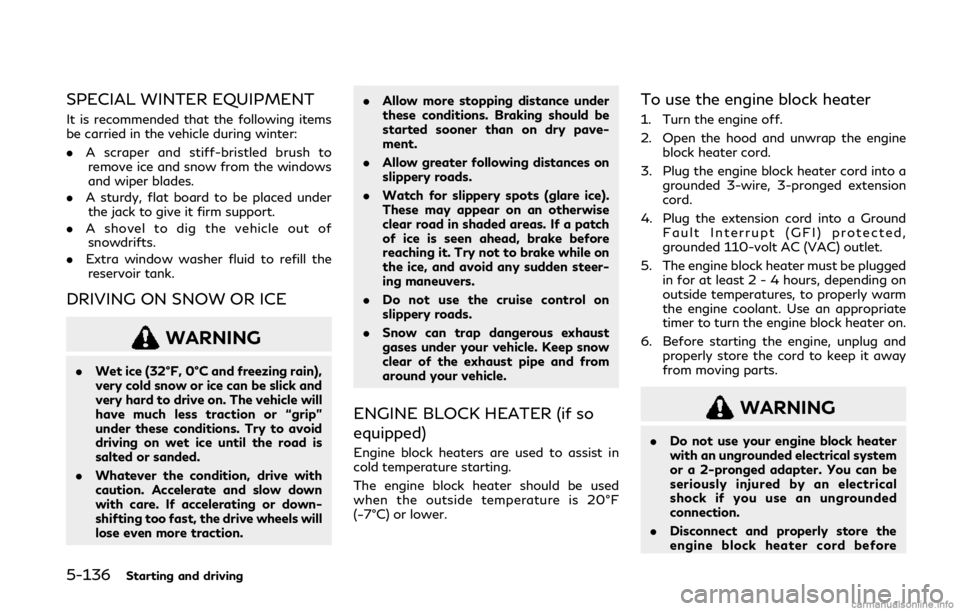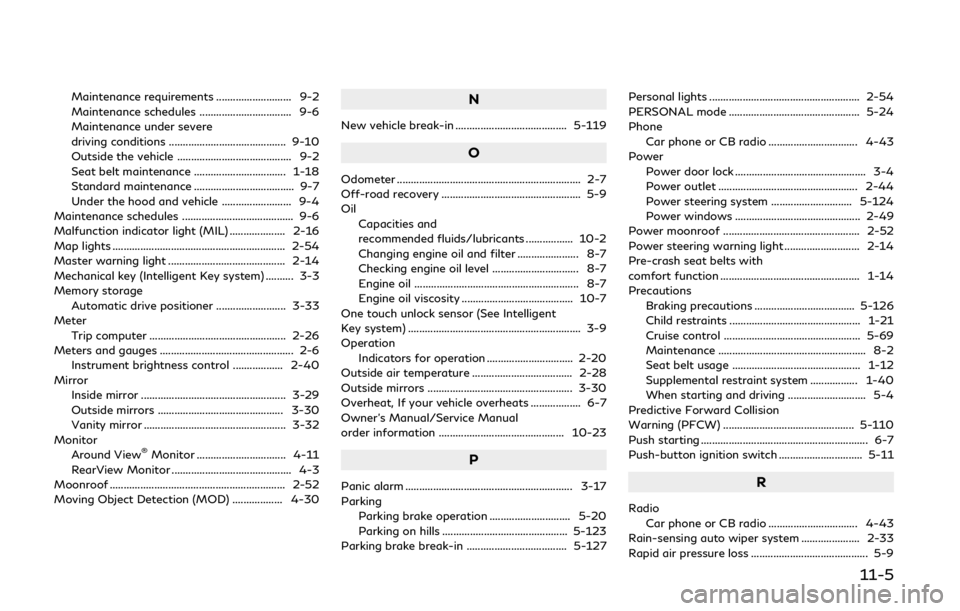wiper fluid INFINITI Q50 2020 Owner's Manual
[x] Cancel search | Manufacturer: INFINITI, Model Year: 2020, Model line: Q50, Model: INFINITI Q50 2020Pages: 468, PDF Size: 2.18 MB
Page 111 of 468

SIC2045
Security indicator light
The security indicator light is located on the
meter panel. It indicates the status of the
INFINITI Vehicle Immobilizer System.
The light blinks after the ignition switch was
in the LOCK, ACC or OFF position. This
function indicates the security systems
equipped on the vehicle are operational.
If the INFINITI Vehicle Immobilizer System is
malfunctioning, this light will remain on
while the ignition switch is in the ON
position.
If the light still remains on and/or the
engine will not start, seek service for the
INFINITI Vehicle Immobilizer System assoon as possible. Please bring all registered
keys that you have. It is recommended you
visit an INFINITI retailer for this service.
WARNING
In freezing temperatures the washer
solution may freeze on the windshield
and obscure your vision which may lead
to an accident. Warm windshield with
the defroster before you wash the wind-
shield.
CAUTION
.
Do not operate the washer continu-
ously for more than 30 seconds.
. Do not operate the washer if the
reservoir tank is empty.
. Do not fill the window washer re-
servoir tank with washer fluid con-
centrates at full strength. Some
methyl alcohol based washer fluid
concentrates may permanently stain
the grille if spilled while filling the
window washer reservoir tank.
. Pre-mix washer fluid concentrates
with water to the manufacturer’s
recommended levels before pouring
the fluid into the window washer
reservoir tank. Do not use the win-
dow washer reservoir tank to mix the
Instruments and controls2-31
WIPER AND WASHER SWITCH
Page 112 of 468

2-32Instruments and controls
washer fluid concentrate and water.
JVI0738X
The windshield wiper and washer operates
when the ignition switch is in the ON
position.
Push the lever down to operate the wiper at
the following speed:
AUTO — see “Rain-sensing auto wiper
system” (P.2-33).
LO — continuous low speed operation
HI — continuous high speed operation
MIST — one sweep operation of the
wiper
Pull the lever toward you
to operate the
washer. Then the wiper will also operate
several times. Pulling up the wiper arm:
The wiper arm should be in the up position
when replacing the windshield wiper blades.
To replace the windshield wiper blades,
follow the procedure below:
1. When the ignition switch is ON or within
60 seconds after placing the ignition
switch from the ON to OFF position,
place the windshield wiper and washer
lever into the OFF position.
2. Rapidly lift the lever
upwards twice
within 0.5 seconds. This action will cause
the wipers to automatically take the
service position.
To return the wiper arm, place the wiper arm
in the down position and operate the wiper
switch once.
CAUTION
Do not operate the windshield wiper
while the wiper arm is pulled up. The
wiper arm may be damaged.
Wiper drip wipe system:
The wiper will also operate once about 3
seconds after the washer and wiper are
operated. This operation is to wipe washer
fluid that has dripped on the windshield.
Page 354 of 468

5-136Starting and driving
SPECIAL WINTER EQUIPMENT
It is recommended that the following items
be carried in the vehicle during winter:
.A scraper and stiff-bristled brush to
remove ice and snow from the windows
and wiper blades.
. A sturdy, flat board to be placed under
the jack to give it firm support.
. A shovel to dig the vehicle out of
snowdrifts.
. Extra window washer fluid to refill the
reservoir tank.
DRIVING ON SNOW OR ICE
WARNING
. Wet ice (32°F, 0°C and freezing rain),
very cold snow or ice can be slick and
very hard to drive on. The vehicle will
have much less traction or “grip”
under these conditions. Try to avoid
driving on wet ice until the road is
salted or sanded.
. Whatever the condition, drive with
caution. Accelerate and slow down
with care. If accelerating or down-
shifting too fast, the drive wheels will
lose even more traction. .
Allow more stopping distance under
these conditions. Braking should be
started sooner than on dry pave-
ment.
. Allow greater following distances on
slippery roads.
. Watch for slippery spots (glare ice).
These may appear on an otherwise
clear road in shaded areas. If a patch
of ice is seen ahead, brake before
reaching it. Try not to brake while on
the ice, and avoid any sudden steer-
ing maneuvers.
. Do not use the cruise control on
slippery roads.
. Snow can trap dangerous exhaust
gases under your vehicle. Keep snow
clear of the exhaust pipe and from
around your vehicle.
ENGINE BLOCK HEATER (if so
equipped)
Engine block heaters are used to assist in
cold temperature starting.
The engine block heater should be used
when the outside temperature is 20°F
(−7°C) or lower.
To use the engine block heater
1. Turn the engine off.
2. Open the hood and unwrap the engine
block heater cord.
3. Plug the engine block heater cord into a grounded 3-wire, 3-pronged extension
cord.
4. Plug the extension cord into a Ground Fault Interrupt (GFI) protected,
grounded 110-volt AC (VAC) outlet.
5. The engine block heater must be plugged in for at least 2 - 4 hours, depending on
outside temperatures, to properly warm
the engine coolant. Use an appropriate
timer to turn the engine block heater on.
6. Before starting the engine, unplug and properly store the cord to keep it away
from moving parts.
WARNING
.Do not use your engine block heater
with an ungrounded electrical system
or a 2-pronged adapter. You can be
seriously injured by an electrical
shock if you use an ungrounded
connection.
. Disconnect and properly store the
engine block heater cord before
Page 377 of 468

8 Do-it-yourself
Maintenance precautions ............................................... 8-2
Engine compartment check locations ......................... 8-3VR30DDTT engine ..................................................... 8-3
Engine cooling system ..................................................... 8-3 Checking engine coolant level ................................ 8-4
Changing engine coolant .......................................... 8-5
Intercooler cooling system ............................................. 8-5 Checking intercooler coolant level ......................... 8-6
Changing intercooler coolant .................................. 8-6
Engine oil ........................................................................\
..... 8-7
Checking engine oil level ........................................... 8-7
Changing engine oil and filter .................................. 8-7
Automatic Transmission Fluid (ATF) .......................... 8-9
Brake fluid ........................................................................\
8-10
Window washer fluid ................................................... 8-10
Battery ........................................................................\
....... 8-11
Checking battery fluid level .................................... 8-12
Jump starting ............................................................. 8-13
Variable voltage control system ................................. 8-13
Drive belts ........................................................................\
. 8-13
Spark plugs ....................................................................... 8-14 Replacing spark plugs .............................................. 8-14 Air cleaner ........................................................................\
8-15
Windshield wiper blades .............................................. 8-15
Cleaning ..................................................................... 8-15
Replacing ................................................................... 8-16
Brakes ........................................................................\
........ 8-16 Self-adjusting brakes ............................................. 8-16
Brake pad wear warning ....................................... 8-16
Fuses ........................................................................\
.......... 8-17 Engine compartment .............................................. 8-17
Passenger compartment ....................................... 8-18
Intelligent Key battery replacement ......................... 8-19
Lights ........................................................................\
......... 8-22 Headlights ................................................................. 8-23
Exterior and interior lights ................................... 8-24
Wheels and tires ............................................................. 8-26 Tire pressure ............................................................. 8-26
Tire labeling ............................................................. 8-30
Types of tires ........................................................... 8-32
Tire chains ................................................................ 8-34
Changing wheels and tires .................................. 8-34
Jacking up the vehicle and replacing tires ...... 8-38
Page 422 of 468

9-4Maintenance and schedules
wear or damage.
Steering wheel:Check for changes in the
steering conditions, such as excessive free
play, hard steering or strange noises.
Warning lights and chimes: Make sure that
all warning lights and chimes are operating
properly.
Windshield defroster: Check that the air
comes out of the defroster outlets properly
and in sufficient quantity when operating
the heater or air conditioner.
Windshield wiper and washer*: Check that
the wipers and washer operate properly and
that the wipers do not streak.
Under the hood and vehicle
The maintenance items listed here should be
checked periodically (for example, each time
you check the engine oil or refuel).
Battery*: Check the fluid level in each cell. It
should be between the MAX and MIN lines.
Vehicles operated in high temperatures or
under severe condition require frequent
checks of the battery fluid level.
NOTE:
Care should be taken to avoid situations
that can lead to potential battery discharge
and potential no-start conditions such as:
1. Installation or extended use of electro-
nic accessories that consume battery power when the engine is not running
(Phone chargers, GPS, DVD players,
etc.)
2. Vehicle is not driven regularly and/or
only driven short distances.
In these cases, the battery may need to be
charged to maintain battery health.
Brake fluid level*: Make sure that the brake
fluid level is between the MAX and MIN lines
on the reservoir.
Engine coolant level*: Check the coolant
level when the engine is cold.
Intercooler coolant level*: Check the coolant
level when the engine is cold.
Engine drive belts*: Make sure that no belt is
frayed, worn, cracked or oily.
Engine oil level*: Check the level after
parking the vehicle on a level spot and
turning off the engine. Wait more than 15
minutes for the oil to drain back into the oil
pan.
Exhaust system: Make sure there are no
loose supports, cracks or holes. If the sound
of the exhaust seems unusual or there is a
smell of exhaust fumes, immediately have
the exhaust system inspected. It is recom-
mended you visit an INFINITI retailer for this
service. (See “Precautions when starting and
driving” (P.5-4).) Fluid leaks:
Check under the vehicle for fuel,
oil, water or other fluid leaks after the
vehicle has been parked for a while. Water
dripping from the air conditioner after use is
normal. If you should notice any leaks or if
gasoline fumes are evident, check for the
cause and have it corrected immediately.
Radiator and hoses: Check the front of the
radiator and clean off any dirt, insects,
leaves, etc., that may have accumulated.
Make sure the hoses have no cracks, defor-
mation, rot or loose connections.
Underbody: The underbody is frequently
exposed to corrosive substances such as
those used on icy roads or to control dust. It
is very important to remove these sub-
stances, otherwise rust will form on the
floor pan, frame, fuel lines and around the
exhaust system. At the end of winter, the
underbody should be thoroughly flushed
with plain water, being careful to clean
those areas where mud and dirt may accu-
mulate. For additional information, see
“Cleaning exterior” (P.7-2).
Windshield washer fluid*: Check that there
is adequate fluid in the reservoir.
Page 461 of 468

Maintenance requirements ........................... 9-2
Maintenance schedules ................................. 9-6
Maintenance under severe
driving conditions .......................................... 9-10
Outside the vehicle ......................................... 9-2
Seat belt maintenance ................................. 1-18
Standard maintenance .................................... 9-7
Under the hood and vehicle ......................... 9-4
Maintenance schedules ........................................ 9-6
Malfunction indicator light (MIL) .................... 2-16
Map lights .............................................................. 2-54
Master warning light .......................................... 2-14
Mechanical key (Intelligent Key system) .......... 3-3
Memory storage Automatic drive positioner ......................... 3-33
Meter
Trip computer ................................................. 2-26
Meters and gauges ................................................ 2-6 Instrument brightness control .................. 2-40
Mirror Inside mirror .................................................... 3-29
Outside mirrors ............................................. 3-30
Vanity mirror ................................................... 3-32
Monitor Around View
®Monitor ................................ 4-11
RearView Monitor ........................................... 4-3
Moonroof ............................................................... 2-52
Moving Object Detection (MOD) .................. 4-30
N
New vehicle break-in ........................................ 5-119
O
Odometer .................................................................. 2-7
Off-road recovery .................................................. 5-9
Oil
Capacities and
recommended fluids/lubricants ................. 10-2
Changing engine oil and filter ...................... 8-7
Checking engine oil level ............................... 8-7
Engine oil ........................................................... 8-7
Engine oil viscosity ........................................ 10-7
One touch unlock sensor (See Intelligent
Key system) .............................................................. 3-9
Operation Indicators for operation ............................... 2-20
Outside air temperature .................................... 2-28
Outside mirrors .................................................... 3-30
Overheat, If your vehicle overheats .................. 6-7
Owner’s Manual/Service Manual
order information ............................................. 10-23
P
Panic alarm ............................................................ 3-17
Parking
Parking brake operation ............................. 5-20
Parking on hills ............................................. 5-123
Parking brake break-in .................................... 5-127 Personal lights ...................................................... 2-54
PERSONAL mode ............................................... 5-24
Phone
Car phone or CB radio ................................ 4-43
Power Power door lock ............................................... 3-4
Power outlet .................................................. 2-44
Power steering system ............................. 5-124
Power windows ............................................. 2-49
Power moonroof ................................................. 2-52
Power steering warning light ........................... 2-14
Pre-crash seat belts with
comfort function .................................................. 1-14
Precautions Braking precautions .................................... 5-126
Child restraints ............................................... 1-21
Cruise control ................................................. 5-69
Maintenance ..................................................... 8-2
Seat belt usage .............................................. 1-12
Supplemental restraint system ................. 1-40
When starting and driving ............................ 5-4
Predictive Forward Collision
Warning (PFCW) ............................................... 5-110
Push starting ............................................................ 6-7
Push-button ignition switch .............................. 5-11R
Radio Car phone or CB radio ................................ 4-43
Rain-sensing auto wiper system ..................... 2-33
Rapid air pressure loss .......................................... 5-9
11-5
Page 464 of 468

11-8
Variable voltage control system ..................... 8-13
VehicleDimensions ................................................... 10-10
Recovery (freeing a stuck vehicle) ............ 6-10
Vehicle Dynamic Control (VDC)
off switch ......................................................... 2-41
Vehicle dynamic control
(VDC) system ................................................ 5-129
Vehicle Dynamic Control (VDC)
warning light ................................................... 2-15
Vehicle identification number (VIN) ............. 10-11
Vehicle information display .............................. 2-18
Vehicle loading information ............................ 10-16
Vehicle security system ...................................... 2-29
Vehicle speedAverage speed ............................ 2-26
Ventilators ............................................................. 4-35
W
Warning Flat Tire - Visit dealer warning ................. 2-21
Hazard warning flasher switch .................... 6-2
Indicators for operation (vehicle
information display) ...................................... 2-20
Lights ................................................................ 2-10
Power steering warning light ..................... 2-14
Predictive Forward Collision
Warning (PFCW) ........................................ 5-110
Tire Pressure Monitoring
System (TPMS) ........................... 5-5, 6-3, 8-26
Vehicle information display ........................ 2-18 Warning lights, indicator lights and
audible reminders .......................................... 2-10
Warning labels Air bag warning labels ................................. 1-58
Warning light Air bag warning light ........................ 1-58, 2-15
Anti-lock braking system (ABS)
warning light ................................................... 2-10
Brake warning light ....................................... 2-11
Forward Emergency Braking (FEB)
system warning light .................................... 2-11
Low fuel warning light ................................. 2-12
Low tire pressure warning light ................ 2-12
Seat belt warning light and chime ............ 2-14
Warranty Emission control system warranty ........ 10-20
Washer switch Wiper and washer switch ........................... 2-31
Washing .................................................................... 7-2
Waxing ....................................................................... 7-2
Welcome light and farewell light function .... 3-10
Wheel/tire size ..................................................... 10-9
Wheels and tires .................................................. 8-26
Care of wheels .................................................. 7-3
Cleaning aluminum alloy wheels .................. 7-3
Cleaning bright wheels .................................. 7-4
Window washer fluid ......................................... 8-10
Window(s)
Cleaning ............................................................... 7-3
Power windows ............................................. 2-49 Wiper
Rain-sensing auto wiper system ............... 2-33
Wiper and washer switch ........................... 2-31
Wiper blades ................................................... 8-15
Wiper and washer switch ................................. 2-31